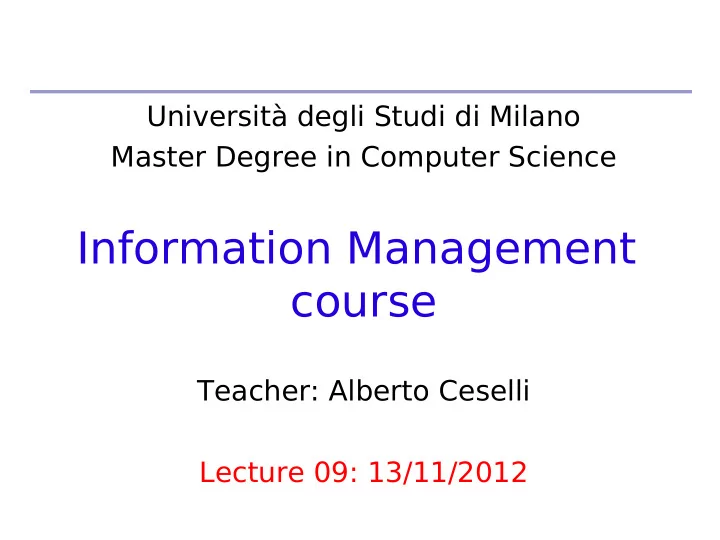

Università degli Studi di Milano Master Degree in Computer Science Information Management course Teacher: Alberto Ceselli Lecture 09: 13/11/2012
L. C. Molina, L. Belanche, A. Nebot “Feature Selection Algorithms: A Survey and Experimental Evaluation”, IEEE ICDM (2002) and L. Belanche, F. Gonzales “Review and Evaluation of Feature Selection Algorithms in Synthetic Problems”, arXiv – available online (2011) 2 2
Feature Selection Algorithms Introduction Relevance of a feature Algorithms Description of fundamental FSAs Generating weighted feature orders Empirical and experimental evaluation 3
Algorithms for Feature Selection A FSA can be seen as a “computational approach to a definition of relevance” Let X be the original set of features, |X| = n Let J(X') be an evaluation measure to be optimized: J: X'⊆X → ℝ (1)Set |X'| = m < n; find X' ⊂ X such that J(X') is maximum (2)Set a value J 0 ; find X' ⊂ X such that |X'| is minimum, and J(X') ≥ J 0 Find a compromise between (1) and (2) Remark: an optimal subset of features in not necessarily unique Characterization of FSAs Search organization Generation of successors Evaluation measure 4
Characterization of FSAs search organization General strategy with which the space of hypothesis is explored Search space: all possible subsets of features A partial order in the search space can be defined, as S1 ≺ S2 if S1 ⊂ S2 Aim of search: explore only a part of all subsets of features → for each subset relevance should be upper and lower bounded (estimates or heuristics) Let L be a (labeled) list of (weighted) subsets of features → states L maintains the current list of (partial) solutions, and the labels indicate the corresponding evaluation measure 5
Characterization of FSAs search organization We consider three types of search: Exponential search (|L| > 1): Search cost O(2 n ) Extreme case: exhaustive search If given S1 and S2 with S1 ⊆ S2 then J(S1) ≥ J(S2) → then J() is monotonic and branch-and-bound is optimal! A* with heuristics is another option Sequential search (|L| = 1): Start with a certain state and select a certain successor Never backtrack Search cost is polynomial, but no optimality guarantee Random search (|L| > 1): Pick a state and change it somehow (local search) Escape from local minima with random (worsening) moves 7
Characterization of FSAs generation of successors Five operators can be used to move from a state to the next Forward: start with X' = empty set Given a state X', pick a feature x ∉ X' such that J(X' U {x}) is largest Stop when J(X' U {x}) = J(X'), or |X'| = certain card., or … Backward: start with X' = X Given a state X', pick a feature x ∊ X such that J(X' \ {x}) is largest Stop when J(X' \ {x}) = J(X'), or |X'| = certain card., or … Generalized Forward and Backward: consider sets of features for addition / removal at each step Compound: perform f consecutive forward moves and b consecutive backward moves Random 8
Characterization of FSAs evaluation measures Several problem dependent approaches What counts is the relative values assigned to different subsets: e.g. classification Probability of error: what's the behavior of a classifier using the subset of features? Divergence: probabilistic distance among the class- conditional probability densities Dependence: covariance or correlation coefficients Interclass distance: e.g. dissimilarity Information or Uncertainty: exploit entropy measurements on single features Consistency: an inconsistency in X' and S is defined as two instances in S that are equal when considering only the features in X', but actually belong to different classes (aim: find the minimum subset of features leading to zero inconsistencies) 9
Characterization of FSAs evaluation measures Example: Consistency an inconsistency in X' and S is defined as two instances in S that are equal when considering only the features in X', but actually belong to different classes (aim: find the minimum subset of features leading to zero inconsistencies) IC X' (A) = X'(A) – max k X' k (A) X'(A) = number of instances of S equal to A when only the features in X' are considered X' k (A) = number of instances of S of class k equal to A when only the features in X' are considered Inconsistency rate: IR(X') = ∑ A∊S IC X' (A) / |S| J(X') = 1 / ( IR(X') + 1 ) N.B. IR is a monotonic measure 10
General schemes for feature selection Main forms of relation between FSA and “inducer” Embedded scheme: the external method has its own FSA (e.g. decision trees or ANN) Filter scheme: the feature selection takes place before the induction step Wrapper scheme: FSA uses subalgorithms (e.g. learning algorithms) as internal routines 11
General algorithm for feature selection 12
Characterization of a FSA Each algo can be represented as a triple <Org, GS, J> Org: search organization GS: Generation of Successors J: Evaluation measure 13
Feature Selection Algorithms Introduction Relevance of a feature Algorithms Description of fundamental FSAs Generating weighted feature orders Empirical and experimental evaluation 14
Las Vegas Filter (LVF) <random, random, any> 15
Las Vegas Incremental (LVI) <random, random, consist.> Rule of thumb: p = 10% 16
SBG/SFG <sequential, F/B, any> 17
SBG/SFG <sequential, F/B, any> 18
Focus <exponential, forward, consist.> 19
Sequential Floating FS <exponential, F+B, consist.> 20
(Auto) branch&bound <exponential,backward,monotonic> 21
Quick branch&bound <rndm/exp,rndm/back,monotonic> Use LVF to find a good solution Use ABB to explore efficiently the remaining search space 22
Feature Selection Algorithms Introduction Relevance of a feature Algorithms Description of fundamental FSAs Generating weighted feature orders Empirical and experimental evaluation 23
Relief <random, weighting, distance> Closest element to A in S in the same (hit) or a Random_Element different (miss) class 25
Recommend
More recommend